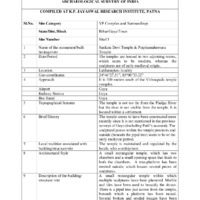Documentation Sheet of Built Heritage/Site N.M.M.A., Archaeological Survey of India for Prapitamaheshavara Temple and Shankata Devi Temple
Item
-
Title
-
Documentation Sheet of Built Heritage/Site N.M.M.A., Archaeological Survey of India for Prapitamaheshavara Temple and Shankata Devi Temple
-
Subject
-
Hindu temples--India
-
Geographic coordinates (latitude, longitude)
-
24° 46' 27.51", 85° 0' 33.32"
-
Brief history
-
The temple seems to have been constructed more recently since it is not mentioned in the previous surveys of Gaya (including Patil’s account). The sculptural pieces within the temple precincts and outside (beneath the pipal tree) seem to be of the early medieval period.
-
Local tradition
-
The temple is maintained and regulated by the locals, who worship here.
-
Location
-
Lakhana pura locality
-
Topographical features
-
It is located at the southern edge of the Mundaprstha hill. The temple is not too far from the Phalgu river but the river is not visible from the temple. It is located within a settlement.
-
Usage
-
Temple is used locally by the inhabitants of Lakhanpura locality, who worship Siva linga, other Shaiva images and the AstaMatrika panel.
-
Structure
-
A small rectangular temple within which multiple sculptures have been plastered. Marble and tiles have been used to beautify the shrine. There is a pipal tree just across from the temple, beneath which a platform has been raised. Several broken and eroded images have been placed on the platform.
-
Approachs
-
500 meters south of the Vishnupada
-
Airport
-
Gaya
-
Building materials
-
Brick
-
stones
-
marble
-
tiles
-
Railway station
-
Gaya
-
Bus stand
-
Gaya
-
Present condition
-
Most sculptures here are eroded and broken.
-
Omeka identifier
-
sci-site13-KPJRForm.pdf
-
Site number
-
site13
-
Abstract
-
Most of these images were brought to the temple from the river as explained by the priest. They were thrown and he and his father picked them up from the river and installed them. However this claim need not be taken on the face value. Whenever new shrines were erected in Gaya, priests tended to collect sculptures from different places and install them within their shrines. This may have been the case at this shrine as well.
Also the name of the shrine as Prapitamahesvara seems to be a smart strategy to use a pre-existing familiar name to build a reputation/following for the shrine.
-
Protection status
-
Sculptures inside the shrine are plastered and seem safe since the temple has a grill and lock. However, broken fragments outside are unsafe but they may not attract any attention because of their present condition.
 sci-site13-KPJRForm.pdf
sci-site13-KPJRForm.pdf